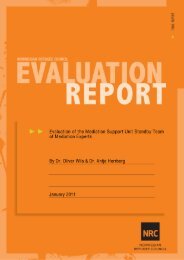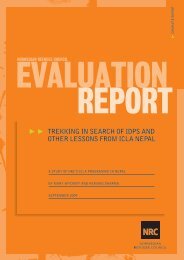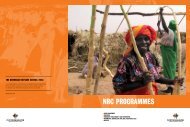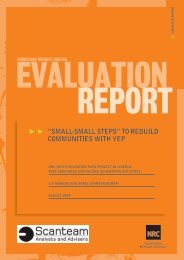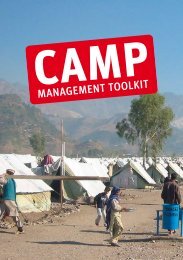evaluation of general food distribution in northern uganda: gulu ...
evaluation of general food distribution in northern uganda: gulu ...
evaluation of general food distribution in northern uganda: gulu ...
You also want an ePaper? Increase the reach of your titles
YUMPU automatically turns print PDFs into web optimized ePapers that Google loves.
7 PROJECT EFFECTIVENESSHav<strong>in</strong>g assessed the performance and challenges <strong>in</strong> terms <strong>of</strong> Relevance/Appropriateness <strong>in</strong>project design and response as well as project Efficiency/Coverage this chapter, deals withproject Effectiveness, i.e. fulfilment <strong>of</strong> the three GFD objectives. The objectives will beanalysed <strong>in</strong> turn, and at the end <strong>of</strong> each section lessons learned and recommendations willbe drawn up.7.1 Project Objective 1To Contribute to HH <strong>food</strong> security and ma<strong>in</strong>ta<strong>in</strong> the m<strong>in</strong>imum nutritional anddietary standard by provid<strong>in</strong>g <strong>food</strong> assistance to people affected bydisplacement <strong>in</strong> camps <strong>in</strong> Gulu, Amuru, and Kitgum.7.1.1 Traditional Nutrition & Diet <strong>in</strong> Northern UgandaThe traditional (pre IDP camps) nutrition and dietary system <strong>in</strong> No rthern Uganda consisted <strong>of</strong>a variety <strong>of</strong> gra<strong>in</strong>s, cereals, vegetables, fruits, meats as well as seasonal delicacies. Apartfrom nutritional values, some <strong>food</strong> elements were culturally favoured for the growth <strong>of</strong>children and help <strong>in</strong>crease breast milk for nurs<strong>in</strong>g mothers 66 . The box below gives an idea:Box 4: Traditional Acholi FoodAround each homestead, there were plots <strong>of</strong> land for grow<strong>in</strong>g vegetables like Malakwang (a bitter-sour butdelicious and nutritious vegetable) , Boo (the staple vegetable <strong>of</strong> the Acho li) Akeyo, Oyado (Green vegetables)pumpk<strong>in</strong>, tomatoes, cabbages, beans and Irish Potatoes. The homestead plots were also used to grow cassava,sweet potatoes, maize (for cob consumption as opposed to produc<strong>in</strong>g flour) and fruits like mangoes, pawpaw,oranges, lemon, guavas and tanger<strong>in</strong>es. A mile or two from the homesteads were the ma<strong>in</strong> family gardens <strong>of</strong>small farms where millet and simsim (the ma<strong>in</strong> staple <strong>food</strong> <strong>of</strong> the Acholi), were grown. Other ma<strong>in</strong> <strong>food</strong> cropsgrown here <strong>in</strong>cluded Lapena (Chick peas), groundnu ts, sorghum for brew<strong>in</strong>g beer. Each family had a m<strong>in</strong>imum <strong>of</strong>two granaries ( dero) to store millet and simsim. The <strong>food</strong> stored would always last past the next harvest. Othergranaries were built to store peas and groundnuts. Nearly every family kept poultry, a few goats and sheep, whichwere reared <strong>in</strong> and around the homestead and many families kept cattle reared with<strong>in</strong> the village.The fruits consumed <strong>in</strong>cluded the Shea nut (Yaa) from which –Shea butter ( Moo Yaa) was extracted. Moo Yaawas ma<strong>in</strong>ly used <strong>in</strong> sauce s, but also served as a body lotion for women and children. Other fruit trees <strong>in</strong>cludeTugu (palm tree), Cwaa (Tamar<strong>in</strong>d), Langoo, Ocoga, Oywelo . People had Beehives ( Bong) <strong>in</strong> communal graz<strong>in</strong>gareas or forests for honey.Grasshoppers ‘Nsenene’ ( Ocene) or fungi like mushrooms ( Obwol) were also popular seasonal delicacies. Dur<strong>in</strong>gthe dry season (November to February), there were jo<strong>in</strong>t hunt<strong>in</strong>g sessions <strong>in</strong> the forests (Buffalo, Antelopes, fieldrats). The average family also set traps for small animals like rab bits and birds like Gu<strong>in</strong>ea Fowls (Aweno) <strong>in</strong> andaround their gardens.7.1.2 Nutrition & Diet Provided Dur<strong>in</strong>g the ConflictWith the <strong>in</strong>creas<strong>in</strong>g <strong>in</strong>surgency and large parts <strong>of</strong> the population <strong>in</strong> IDP camps andsubsequent <strong>in</strong>troduction <strong>of</strong> the WFP <strong>food</strong> <strong>distribution</strong> the Acholi diet changed dramatically.From a rich and diverse diet, IDPs were now given carefully calculated <strong>food</strong> rations withselected items to compose the <strong>food</strong> basket. The rations normally <strong>in</strong>clude cereals (maize orsorghum), pulses (beans or yellow split peas) and vegetable oil enriched with Vitam<strong>in</strong> A.Dur<strong>in</strong>g the 10 years <strong>of</strong> <strong>food</strong> <strong>distribution</strong> there has been little variation <strong>in</strong> the <strong>food</strong> basket.66Detailed research provided by Jane Oryem. An example <strong>of</strong> a typical Acholi menu is found <strong>in</strong> Annex 5.25





